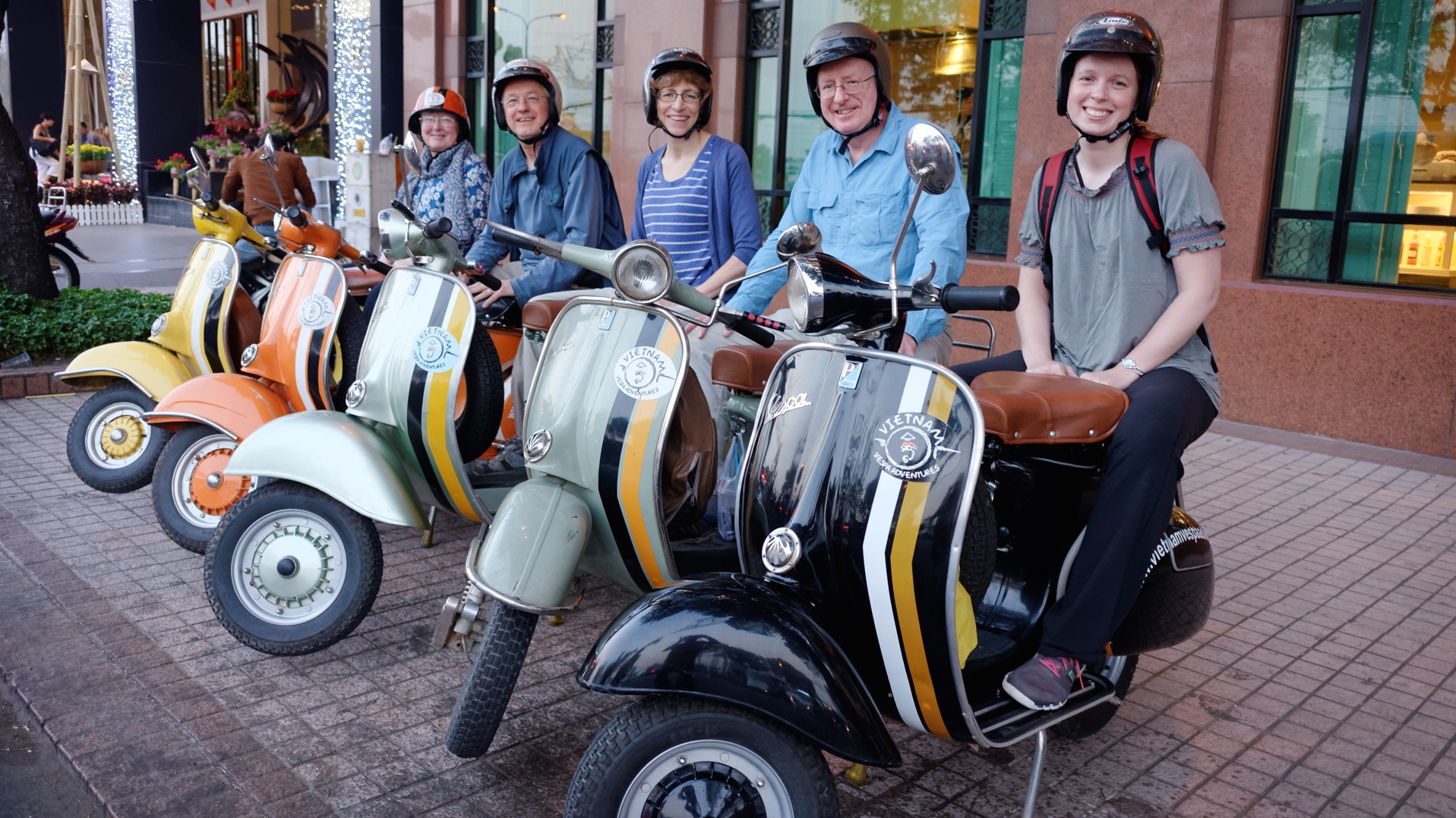"Just trust your driver."
And so saying, I was deposited on the back of a Vespa and sent off onto the streets of Saigon.
Let's take a moment to describe the traffic situation in Vietnam. Imagine taking a glass and filling it with pebbles. Once it is full to the brim, you pour gravel into all the cracks. Then shake. Now switch the pebbles for 1.6 million cars and the gravel for the 37 million motorbikes that weave around them. Such are the streets of Vietnam. And those numbers are two years out of date. Our glass analogy lacks traffic control systems such as stopping at lights, keeping to lanes and travelling in a certain direction. Frankly, so did the reality.
I failed to take a photograph that truly captures the traffic of Vietnam, but this one at least gives a glimpse: check out the babies on motorcycles.
The nearest experience I had previously had to Vietnamese roads was those of India, whose increased diversity (goats were often involved) was balanced by the fact I was always in a vehicle larger than a motorcycle. On this night however, I was on a Vespa tour of Ho Chi Minh City, where anyone who managed to not faint with terror was treated to a dinner of street vender cuisine.
The verdict? It was amazing. (Although it should be noted that my parents did have multiple cocktails at the first stop before getting back on their Vespas.)
As a passenger, you sit behind a driver and hold onto the handle on the driver's seat back. We were also given a helmet; a safety accessory that became compulsory in 2001. It is a law largely obeyed except (somewhat disturbingly) by the passengers who are small children. My helmet was a reassuring addition, although I did struggle not to picture the skin being ripped from my body as my bones skittered along the tarmac.
This was naturally ridiculous: there was never enough tarmac visible for decent skittering.
Street cafe sea food. Spot the 'jumping chickens' in the lower right.
Cars in Vietnam are taxed incredibly heavily, receiving a 200% mark-up that leaves the cheapest Toyota costing around $45,000 USD. A Honda motorbike, on the other hand, costs around $1000 and will last for ten years. The city therefore runs on two wheels.
Vespas are the slower cousins of the Honda bikes, but this hardly matters on the packed roads. They are often preferred by Vietnam's girls (our guide told us), since their deficit in speed is compensated by the opinion that the rider look cuter travelling around town. However, the cost of beauty is always high, and Vespa prices kick in around $5000.
Getting your driver's license is not particularly expensive, but the fines for being pulled over while driving illegally are about $100 USD (a heftier sum in Vietnam than in the USA). While this is hopefully a deterrent, it is also possible to slip the officer a fiver as 'coffee money' and escape in a puff of mild corruption.
The larger of the street cafes we visited
The official number of people allowed on a motorcycle is two adults and a child (riding in-between the adults), but this was violated at least once in every direction I looked. Balancing children on motorbikes seems an extreme sport, but the cost of cars likely reduces people's options.
Ho Chi Minh city is divided into 24 districts, 12 of which have only their numeral designation (e.g. district 3) rather than a name. This made the expedition sound dangerously like the 'Hunger Games'; an appropriately byline for a food tour, but the analogy with the fictional deathly contest is not comforting when you're weaving between two huge lorries and have just passed a coffin shop. Mercifully, the drivers were clearly very experienced and I never actually felt unsafe. (Almost never.)
Street food! Clockwise from top left: crab legs, oysters, hot pots
The original name for Vietnam's largest city is Saigon, and this is still used extensively on the streets, if not on official notices. Interestingly, our hotel provided a map annotated in both English and Japanese, with the former saying 'Ho Chi Minh City', while the latter read 'Saigon'. It is not clear if this reflects a lack of awareness of global affairs or a political statement. Both are plausible.
Our tour took us into three of the districts, stopping at different outdoor venders, a secret cafe and a bustling bar with loud pop music. The food was amazing, with stacks of sea food that included crap claws, oysters, muscles and shrimp. It got rather more exciting when 'jumping chicken' appeared: this turned out to be frog, as revealed by the original product that gulped wetly in a tank at the front of the vender. (For the record, it tasted like chicken.)
Cafe through here.... what?
After eating in three different places, we were rolled into a cafe with a hidden entrance off the back of a storage area. In truth, its location can hardly have been a secret, since the room was busy with tourists. Nevertheless, we certainly could not have found it alone. In low lit, romantic lighting, one of the entertainers walked to the small stage and strummed pensively on his guitar.
"I'd like to dedicate this song… to myself."
Finally, it was a whimsical devotion I found I could really get behind.





